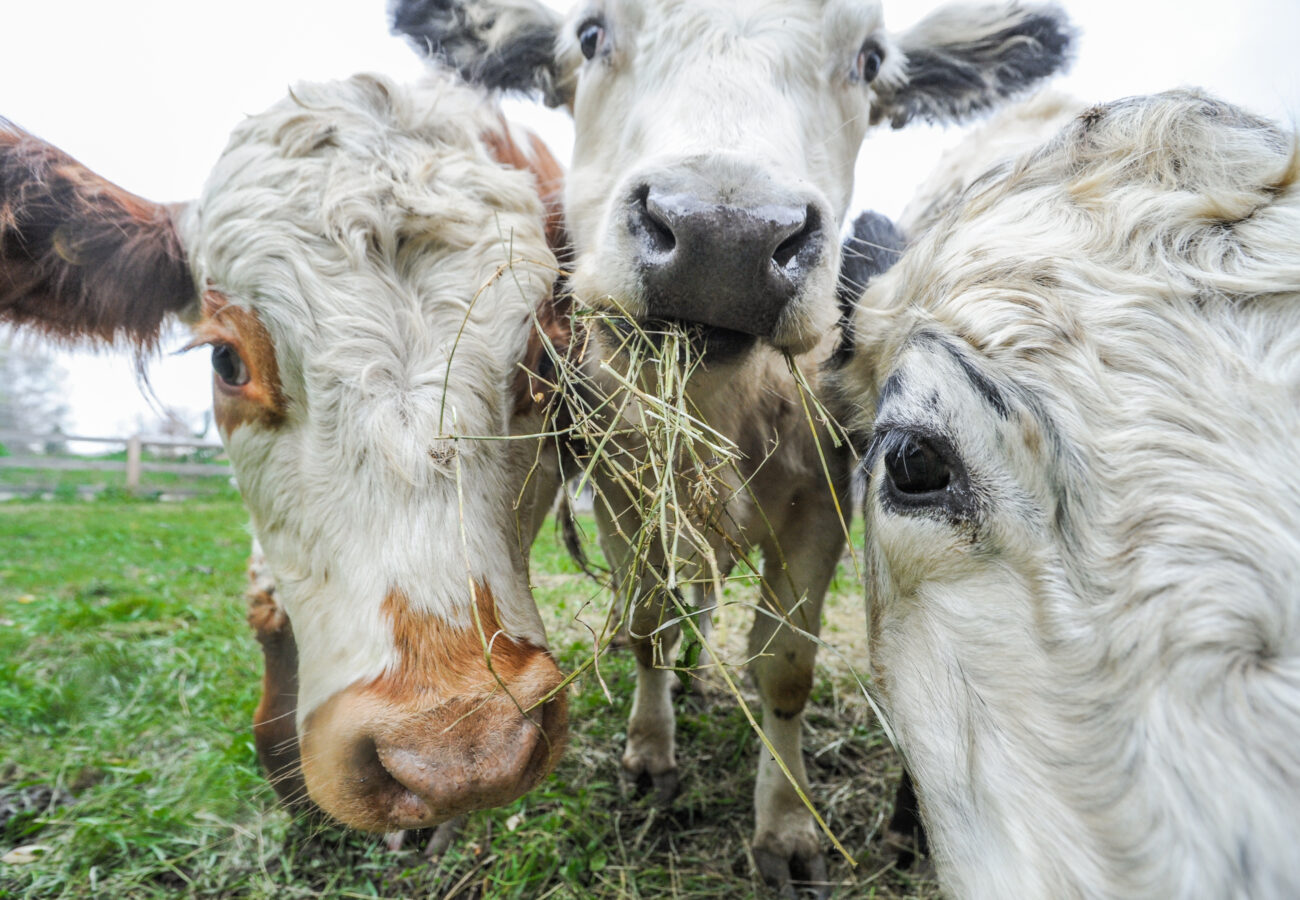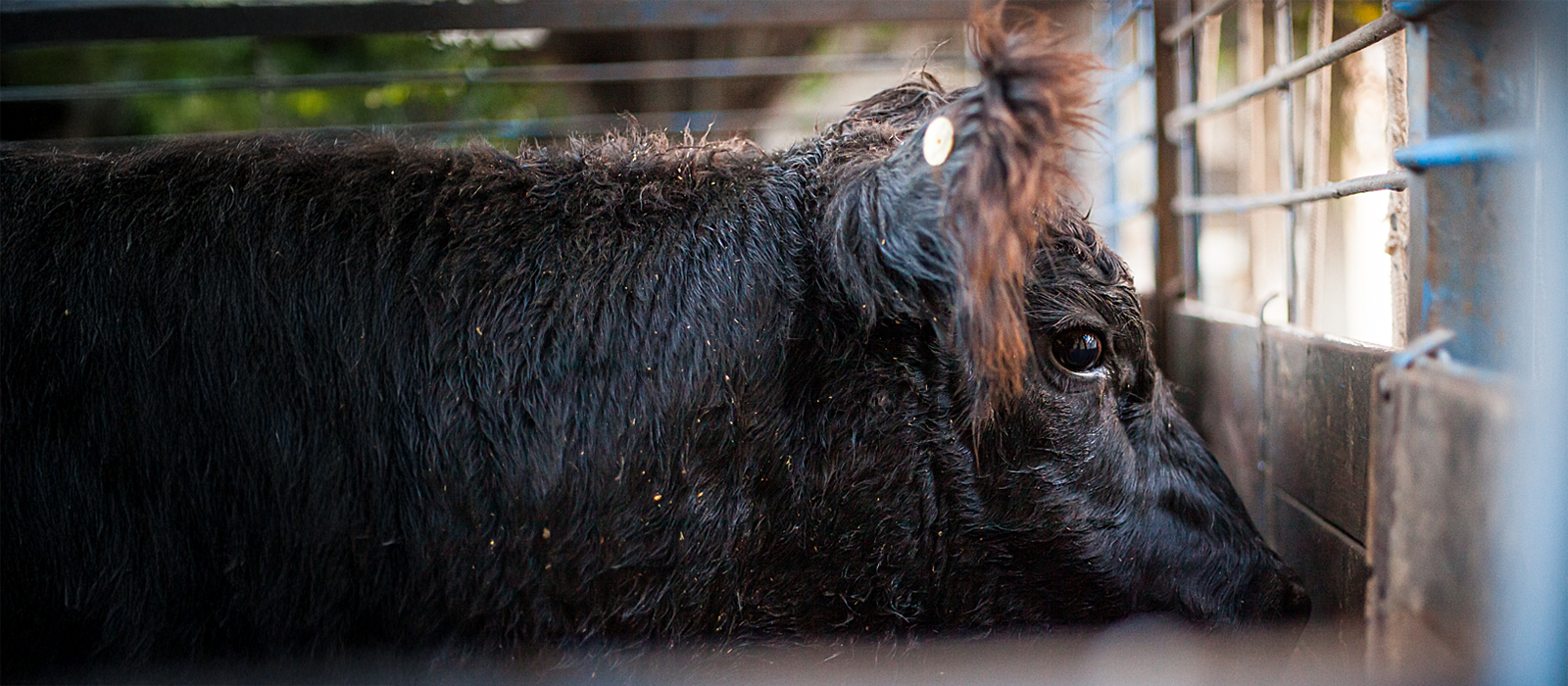In natural conditions, cows choose to live in small, matriarchal groups and form close bonds with each other, using different vocalisations for different family members and even grieving when separated. The farming industry destroys these bonds, forcing cows to live in huge herds and separating mothers from their calves. In the UK, cows farmed for their milk (dairy) and meat (beef) account for almost 10 million individuals.
Farming cows for ‘beef’
The beef industry is huge and complex, with around 8 million cows farmed for their meat in the UK, as of July 2023. This is made up of several ‘supply’ chains, including “prime cattle” raised solely for beef production and cows or calves from the dairy industry. Some estimates say that around 50% of beef production comes from the dairy herd, either from unwanted male calves who cannot produce milk or mothers who are no longer able to produce the vast quantities of milk demanded of them.
Even in so-called ‘higher welfare’, ‘grass fed’ or ‘organic’ systems, mutilations and cow-calf separation is standard practice as well as the terrifying journey to the slaughterhouse where their lives are cut cruelly short.
‘Suckler calves’ are those who are reared by their mothers until they are forcibly weaned, by human intervention, then transported to ‘finishing’ farms where they’ll be fed a rich diet designed to fatten them up for slaughter. ‘Finishing’ is a euphemism for getting calves to the most profitable weight possible to make the most money.
Forced weaning places nutritional, social and physical stress on the calf as well as the psychological stress of separating mothers and babies. In natural conditions, male calves would suckle for 9-12 months while females would live with their mothers for life. Some farmers will only separate mothers and calves with fences while others will use ‘anti-suckling devices’ like the nose flap pictured below. These are considered low-stress by the industry because they allow families to stay together yet calves have an innate need to suckle and experience frustration when unable to do so. Some devices are designed to be painful so that mothers will kick the calf to discourage suckling, risking injury to both her udders and young calves.
A surprising fact is that half of all beef comes from the dairy industry: buying beef quite literally funds the dairy industry, and vice versa. Figures from the Agricultural and Horticultural Development Board show that around 280,000 dairy calves (likely males who cannot produce milk) entered the beef supply chain between 2016-2018. These calves will suffer immensely: from the stress of transport to and from ‘livestock’ markets and a weakened immune system from being fed liquid milk replacement (and moved onto dry food as soon as possible, to maximise profits) mortality rates are high.
‘White veal’ is the name given to the meat of calves (usually male calves discarded by the dairy industry) that is very pale in colour due to the conditions in which they are reared: a diet of powdered milk and restricted iron, and restricted movement to prevent the meat from darkening. For meat to be legally classed as veal, the calves must be less than 8 months old at the time of slaughter.
In the UK, there is now little demand for white veal but there have been attempts to popularise ‘rosé veal’ which is meat that’s slightly darker due to calves being allowed some movement and slightly more fibrous diets. Calves can still be kept in isolation with little to no bedding, and still experience high rates of stress, disease and death.
Worryingly, the dairy industry exports thousands of young calves to Europe every year, where veal is still popular. For example, 95,000 calves were exported to Europe between January-March 2023 from Ireland alone, many of whom will enter the veal industry.
The idyllic view of cows grazing the British countryside is a myth pedalled by the industry. These systems are declining with extensive systems now accounting for less than 50% of UK produced beef. But even extensive systems aren’t without their issues: the availability of food is unpredictable especially in times of drought or heavy snowfall, there is a lack of shelter from adverse weather, and there is still the risk of injury and disease.
An increasing number of UK farms are now using ‘zero grazing’ systems. The US is infamous for these systems, where huge numbers of cows are confined in outdoor, barren pens but no grass in sight. Worryingly, zero-grazing units for cows don’t require a government permit nor does Defra have any official documentation on how many of these systems exist in the UK. In 2022, it was reported that over 1,000 such farms existed with 9 dedicated solely to beef production and 19 for dairy.
In 2016, the director of the National Beef Association said that the move towards zero-grazing units was due to “efficiency” and meeting commercial demand for beef, ignoring the fact that intensive farming is incredibly harmful to animals. In fact, aspects of zero-grazing units directly ignore the Animal Welfare Act 2006, which states that farmed animals must have a “suitable environment” and be able to “exhibit normal behaviour patterns”, such as grazing.
Cows naturally evolved with horns as defence against predators, but when housed in close confinement with high numbers of other cows, these horns can be dangerous. The standard, routine practice is to remove these. If a horn has already attached itself to the skull, then it can be removed with saws, cutting wire or horn shears. Dehorning is an incredibly painful procedure, so a local anaesthesia and cauterisation (to stem the bleeding) should be used – but there is little to no oversight of this. In calves, whose ‘buds’ have not yet developed into horns, a hot iron or burning chemical is applied to kill the tissue, permanently preventing growth. Even with anaesthetic, calves are at risk of acute stress, infection of open wounds, and post-operative chronic pain.
Male calves are castrated despite being slaughtered before reaching sexual maturity. This is likely to encourage weight gain so that they make more money at slaughter or when sold at market. The testicles will either be fitted with a tight rubber ring, which restricts blood flow and causes them to wither and drop off, or the scrotum will be sliced open and the testicles removed, known as ‘surgical castration’. Anaesthetic isn’t required if the calf is less than two months old.
These procedures are completely legal and routine, practiced across both the dairy and beef industry as ‘standard’.
Slaughtering cows
Most cows in the UK are slaughtered at around two years old, but there is a spike in slaughters around 15 months likely due to the increase in intensive systems that ‘finish’ animals (fatten them up to slaughter weight) much quicker. Cows over 30 months of age are not allowed to enter the food supply chain due to risk of BSE (known as ‘mad cow disease’) so there is another spike in slaughters around 29 months of age. A cow’s natural lifespan can be 20 years or more.
Cows are most commonly stunned mechanically with a bolt shot into their heads. The percussive impact of the bolt is supposed to cause instant unconsciousness, so that the cow cannot see, hear or feel the next stage: being shackled by their hind legs, suspended from an overhead conveyor belt, and their throat cut. They are then bled to death.
UK law states that all animals must be stunned before slaughter. However, there are exceptions, such as non-stun slaughter for religious purposes, and cases where stunning has not worked, like when cows move their heads and workers ‘miss’ the bolt gun, having to make several, excruciatingly painful attempts to stun them. There is always the risk that animals may regain consciousness too quickly and be awake for the bleeding and butchering.
Prior to stunning, the moments leading up to slaughter are equally troubling. Cows are social, emotionally intelligent animals who are affected by the anxious cries of other cows. The smell of fear and blood often leads to futile attempts to escape.

Take action for cows
Killing an animal can never be considered humane because animals' lives are as important to them as ours are to us. Take action today for a kinder tomorrow.

